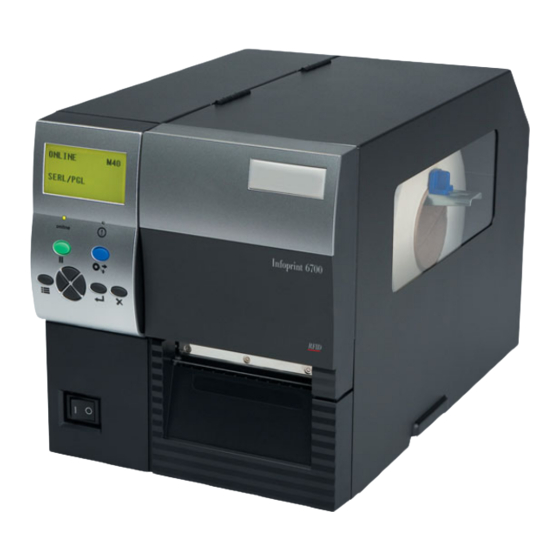Summarization of Contents
1 Overview of Printer Management Utility
Printer Management Utility Core Features
Explains the Printer Management Utility's capabilities for organizing and managing printers remotely.
1 Printer Setup Procedures
Configuring Printer Communication Ports
Details methods (PMU, Telnet, Operator Panel) to configure printer communication ports for PMU interaction.
Getting Started with PMU
Initial Printer Setup and Access Tutorial
Provides a tutorial for setting up and accessing a printer using the PMU.
2 Printer Database Overview
Printer Database Interface Elements
Describes the main components of the printer database window, including menu bar, toolbar, and panes.
File Menu Operations
Managing Database Files
Covers operations like creating, opening, saving, and managing database files.
Edit Menu for Database Management
Adding, Editing, and Deleting Database Items
Explains how to insert, cut, copy, paste, delete, and include/exclude items in the database tree.
2 The Status Menu
Discovering Printers on the Network
Details how to search for printers on a network using the Discover Printers function.
Polling Tab Configuration
Setting Network Polling Intervals and Ranges
Configures how the PMU polls printers on the network, including intervals and IP ranges.
The Utilities Menu
Printer Management and Security Utilities
Covers essential utilities like rebooting printers, setting passwords, and managing wireless properties.
Defining Printer Properties
Printer Identification and Connection Settings
Covers setting up printer properties, including identification, security, and network connections.
3 Applications and Web Access
Configuration Editor for Printer Settings
Explains how to use the Configuration Editor to upload, modify, and download printer configurations.
File Download Application
Downloading Firmware and Configuration Files
Details the process of downloading program files, configuration files, recovery files, and flash files to printers.
3 Media Profiler
Analyzing Media Sensing Problems
Describes the Media Profiler tool for analyzing media sensing issues on thermal printers.
3 Operator Panel
Using the Virtual Operator Panel
Explains how to access and use the virtual operator panel to simulate physical printer controls.
3 Job Capture
Capturing Host Datastreams for Analysis
Details how to capture host datastreams for debugging and diagnosing printer errors.
Web Access to Printer Management
Accessing PMU and Printers via Web Browser
Explains how to access printers and PMU functions using a web browser, including URL and login procedures.
4 Utilities Overview
Printer Management and Security Utilities
Covers essential utilities like rebooting printers, setting passwords, and managing wireless properties.
Set Wireless Properties
Configuring General Wireless Network Settings
Details the configuration of general wireless settings like SSID, network mode, and power saver mode.
4 Macro Utility
Creating and Managing Printer Macros
Explains how to create and use macros for automating printer functions or sending text strings.
SNMP Browser Usage
Viewing Printer MIB Attribute Values
Describes how to use the SNMP Browser to view attribute values in the Printer MIB.
Assign IP Address Remotely
Configuring Printer IP Settings
Details how to assign or reconfigure IP addresses for Ethernet Interfaces remotely.
Configure Print Servers
Managing SNMP Trap Server and Alert Groups
Explains how to set up print servers, trap ports, and configure alert groups for printer events.
5 Datastream Adapter Overview
Understanding Datastream Filtering and CSTs
Introduces the datastream adapter as a filter tool for data manipulation using Character Substitution Tables (CSTs).
CST Manager Operations
Creating and Managing Character Substitution Tables
Details how to use the CST Manager to modify data sent by the host.
CST Modes and Attributes
Understanding Datastream Handling Modes
Explains the fourteen modes available for handling datastreams and their associated attributes.
5 Patterns and Variables
Defining Patterns and Variables for CSTs
Describes how to define patterns and variables used in CST entries for data matching.
Status Response Definition
Configuring Printer Status Responses
Explains how to define printer status bits and responses based on conditions.
5 CST Manager And EBCDIC
Working with EBCDIC Character Sets in CSTs
Provides guidance on using EBCDIC character representations within CST Manager.
Application Name and Version Information
CST Manager Version Control System
Details the CST Manager's Version Control System for assigning application names and version information to files.
Automatic File Backup System
Managing CST File Backups
Explains the automatic backup system for CST files, including file structure and version history.
Backup History
Viewing and Managing CST File Backups
Describes how to view the backup history of CST files, clear history, open versions, and save.
















Need help?
Do you have a question about the 6500 Series and is the answer not in the manual?
Questions and answers